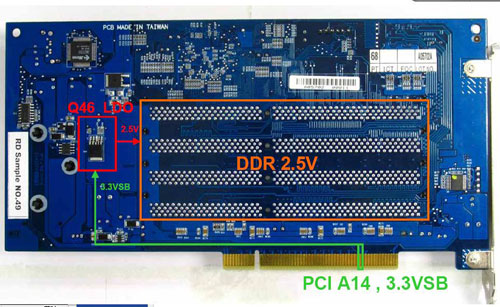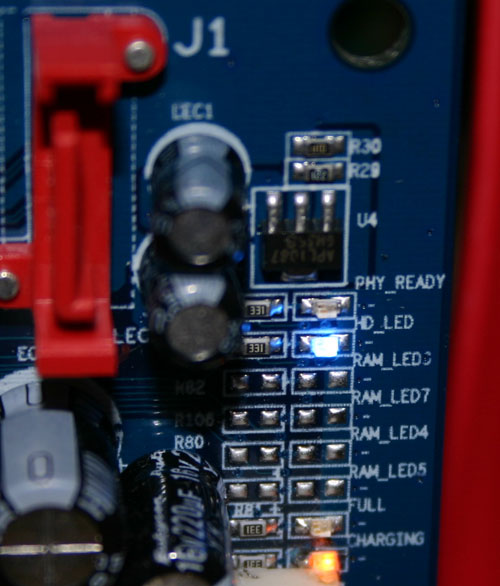Gigabyte's i-RAM: Affordable Solid State Storage
by Anand Lal Shimpi on July 25, 2005 3:50 PM EST- Posted in
- Storage
i-RAM's Limitations
Since your data is stored on a volatile medium with the i-RAM, a loss of power could mean that everything stored on the card would be erased with no hopes for recovery. While a lot of users may keep their computers on 24/7, there are always occasional power outages that would spell certain doom for i-RAM owners. In order to combat this possibility, Gigabyte outfitted the i-RAM with its own rechargeable battery pack.
There are only three conditions where the i-RAM runs off of battery power:
1) When the i-RAM is unplugged from the PCI slot;For whatever reason, unplugging the i-RAM from the PCI slot causes its power consumption to go up considerably, and will actually drain its battery a lot quicker than the specified 16 hours. We originally did this to test how long the i-RAM would last on battery power, but then were later told by Gigabyte not to do this because it puts the i-RAM in a state of accelerated battery consumption.
2) When the power cable is unplugged from your power supply (or the power supply is disconnected from your motherboard; and
3) When the power button on your power supply is turned off.
For the most part, the i-RAM will always be powered. Your data is only at risk if you have a long-term power outage or you physically remove the i-RAM card.
If you run out of battery power, you will lose all data and the i-RAM will stop appearing as a drive letter in Windows as soon as you power it back up. You'll have to re-create the partition data and copy/install all of your files and programs over again.
The card features four LEDs that indicate its status: PHY_READY, HD_LED, Full and Charging.











133 Comments
View All Comments
Sea Shadow - Monday, July 25, 2005 - link
I wonder if the OS is the limiting factor. They should run some tests using other os *cough* linux *cough*.What would be really neat is if they could design an i-Ram device that uses 2 HDD bays and supported 8+ GB of ram and ran from a standard molex.
sprockkets - Tuesday, July 26, 2005 - link
You people think about using Knoppix and copying to the drive? For that matter, that and stuff like damnsmalllinux and such can be run totally from system ram.Instead of using this though for a slient drive, you are better off using flash memory drives for that.
ViRGE - Monday, July 25, 2005 - link
Unfortunately if they did that, it would mean that your computer could never be turned off. As noted in the review, the card is currently still powered even if the machine is "off", due to the fact that when a modern ATX computer is off, it's actually more of a super-standby mode that leaves a few choice items powered on for wake-on events(LAN/modems, and the power button of course). All Gigabyte is doing here is taping in to the 3.3v line on the PCI slot that wake-on power is provided through, which is enough to keep the device powered up even when the system is in its diminished state.Molex plugs on the other hand are completely powered down when the system is "off", so it would be running off of battery power in this case. A lot of us leave our systems on 24/7 anyhow, but I still think they'd have a hard time selling a device that would require your computer to be off for no more than 16 hours at a time.
Gatak - Monday, July 25, 2005 - link
They could use the USB power. On most motherboards you can enable with a jumper or BIOS to supply standby power to the USB. Often the setting is called "Wake on USB" or "Wake on Keyboard" etcreactor - Monday, July 25, 2005 - link
"What would be really neat is if they could design an i-Ram device that uses 2 HDD bays and supported 8+ GB of ram and ran from a standard molex."Was thinking something similar myself as i was reading.
I think once ram modules are 4gb or larger, then this could be very useful. But not until it gets updated with sata2, ddr400 etc. When the time comes to build an HTPC then ill give this another look.
Nice article.
ranger203 - Monday, July 25, 2005 - link
Not to shabby, but i was honestly expecting like 3 second boots, & 5 second game load times... why is there only a 20% speed increase in some areas?Griswold - Thursday, July 28, 2005 - link
Because the data still has to be processed after being loaded - bandwith is obviously not the biggest bottleneck here.forwhom - Tuesday, July 26, 2005 - link
What I would be very interested in seeing is the performance of the thing using it as the source for encoding a dvd/mpeg... Most encoders are heavily disk-based and if it could reduce the time significantly it might be worth while - assuming that eventually they come out with one big enough to hold the source. There's now reasonable CPU encode performance, just have to get the data to/from it... maybe the i-drive would help..highlandsun - Monday, July 25, 2005 - link
Hmmm, the WD Raptor has a sustained transfer rate of 72MB/sec. So on a freshly formatted drive, with no fragmentation, it should still be half the speed of the iRam. But at $200 for a 74GB drive, then you could get a pair of these running in RAID0, which would run at around 140MB/sec anyway, and still have spent less than the cost of the iRam and 4GB of DDR DIMMs. It definitely seems like this product falls short.The use of PCI 3.3V standby power is clever. Perhaps a future version should just use a dummy PCI card to provide the power, connected to a 5" drive-size case with many more DIMM slots. If you can't cram at least 16 DIMMs in there, then the ability to use old memory is kind of wasted, since the old modules will have such small capacities.
Ultimately I think this type of product will always be a failure.
What they should do instead is make it a pass-through cache for a real SATA drive. So you plug the SATA controller into it, and plug it into a real SATA drive, and it caches all I/O operations to the real drive. That's the only way that you can get meaningful benefit out of only 4GB of memory. A card like this would turn any SATA drive into a speed demon; 4GB is definitely a decent size for most caching purposes.
highlandsun - Monday, July 25, 2005 - link
Of course the next logical step is to put the DIMM slots on the SATA controller card, so that access to cached data occurs at real memory speeds, not just SATA bus speed. This would only be a useful product for folks stuck on 32-bit systems, because otherwise it would be best to just increase the system memory instead. But there are plenty of 32-bit systems out there that would benefit from the approach.